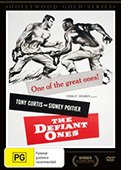The Defiant Ones (1958) (NTSC) |
|
The Defiant Ones (1958) (NTSC) |
|


|
| BUY IT |
| General | Extras | ||
| Category | Drama | None | |
| Rating |

|
||
| Year Of Production | 1958 | ||
| Running Time | 96:18 (Case: 95) | ||
| RSDL / Flipper | No/No | Cast & Crew | |
| Start Up | Menu | ||
| Region Coding | 1,2,3,4,5,6 | Directed By | Stanley Kramer |
|
Studio
Distributor |
 Shock Entertainment |
Starring |
Sidney Poitier Tony Curtis Theodore Bikel Charles McGraw Cara Williams Lon Chaney Jr Claude Akins King Donovan |
| Case | Amaray-Opaque | ||
| RPI | ? | Music | Ernest Gold |
| Video (NTSC) | Audio | ||
| Pan & Scan/Full Frame | Full Frame | English Dolby Digital 2.0 mono (192Kb/s) | |
| Widescreen Aspect Ratio | 1.66:1 | ||
| 16x9 Enhancement |
 |
||
| Video Format | 480i (NTSC) | ||
| Original Aspect Ratio | 1.66:1 | Miscellaneous | |
| Jacket Pictures | No | ||
| Subtitles | None | Smoking | Yes |
| Annoying Product Placement | No | ||
| Action In or After Credits | No | ||
†††† A truck transporting convicts to a southern gaol crashes in a rain storm and two prisoners escape into the swamps. They are the resentful black African American Noah (Sidney Poitier) and white low level criminal Joker (Tony Curtis). There is mutual dislike and enmity between them but as they are chained together by a heavy metre long chain they are unable to break they must learn to work together if they are to escape. On their trail is a posse with bloodhounds led by Sheriff Max Muller (Theodore Bikel) and state police Captain Frank Gibbons (Charles McGraw). When, after a few days and various trials, the pair stumble upon an isolated farm containing only a woman (Cara Williams) and her young son (Kevin Coughlin), they have the opportunity to break the chain that binds them physically and metaphysically. But will one now sacrifice the other?
†††† Made in 1958 with its theme of racial tolerance The Defiant Onesís images of white and black shackled together would be more powerful then with America in the midst of civil rights activities such as the Montgomery Bus Boycott in Alabama (1955-56), the Greensboro sit ins in North Carolina (1960) or the Selma march (1965), although given the current spate of police shootings and riots in the US it is clear that there is still a long way to go. The director of The Defiant Ones Stanley Kramer was interested in issues of race and justice and his films include Judgment at Nuremberg (1961) and Guess Whoís Coming to Dinner (1967). However, the strength of The Defiant Ones is that nowhere does Kramer or his screenwriter indulge in preaching; the actions of Poitier and Curtis carry the message while the southerners are not portrayed as stereotypes or criticised for the racist attitudes so prevalent at the time. Indeed, Sheriff Muller leading the hunt is a liberal and humane man, making the distinction to the posse that there is clear difference between hunting an animal and men, and he later stops the dog handler letting lose the savage Dobermans on the escapees. Theodore Bikel is excellent in this role for which he was nominated for a Best Supporting Actor Oscar but didnít win.
†††† Indeed, The Defiant Ones was nominated for nine Oscars, but won only for its screenplay and black and white cinematography. It was nominated for best picture and best director, but lost out to the feel good Gigi and director Vincente Minnelli; Kramer over his career was nominated for nine Oscars, but won not one! Both Poitier and Curtis were nominated in the best actor category for The Defiant Ones but lost to David Niven in Separate Tables. Not to take anything away from Niven, but both Poitier and Curtis are on screen almost all the time and carry the picture with superb performances. Poitier is mesmerising; athletic, subtle and powerful. I am not suggesting he did not win because of his colour, but it is interesting that when he did win an Oscar for Lilies of the Field in 1963, he was the first and only African-American winner until Denzel Washington 38 years later for Training Day (2001). Curtis was not the first choice for the role of Joker, that was to be Marlon Brando, but Curtis was keen to get away from his pretty boy image and gave one of the best performances of his long career. The other acting nominee was Cara Williams in the best supporting actress category, but again she did not win. I found her performance in The Defiant Ones somewhat artificial and forced, as opposed to the natural performances by the others. Other familiar faces in the cast include Lon Chaney Jr, Claude Akins and King Donovan.
†††† With its themes of tolerance and race, The Defiant Ones remains as powerful, and perhaps as relevant, today as when it was made over 55 years ago. With a fine script, wonderful performances and superb black and white photography The Defiant Ones is infinitely rewatchable.
†††† The Defiant Ones is presented in an aspect ratio of 1.66:1, the original theatrical ratio, and is not 16x9 enhanced.
†††† The film is wonderful to look at given its age. Detail, both close-up and wide, is crisp, the blacks are deep, luminous and rock solid, shades of grey pristine and shadow detail great. Grain is pleasing and controlled, brightness and contrast consistent.
†††† There are occasional flecks throughout the print but most are tiny and not distracting. The biggest I noticed was at 88:23 but it was only fleeting. There was also noticeable motion blur against mottled backgrounds such as trees or building interiors.
†††† There are no subtitles.
| Sharpness | |
| Shadow Detail | |
| Colour | |
| Grain/Pixelization | |
| Film-To-Video Artefacts | |
| Film Artefacts | |
| Overall |
†††† Audio is an English Dolby Digital 2.0 mono track at 192 Kbps.
†††† Dialogue was mostly easy to hear. The original score is credited to Oscar winner Ernest Gold (Exodus (1960)) but in reality the filmís music is limited to songs sung by Poitier or music playing on a portable radio carried by one of the posse. Instead the film makes good use of natural sounds, such as the rain, frogs, insects and birds, as well as the clink of the metal chain. While obviously lacking depth, the Foley is surprisingly effective. Naturally there is no surround or sub-woofer use.
†††† Lip synchronisation was fine.
| Dialogue | |
| Audio Sync | |
| Clicks/Pops/Dropouts | |
| Surround Channel Use | |
| Subwoofer | |
| Overall |
†††† Nothing. The menu offers play and chapters.
NOTE: To view non-R4 releases, your equipment needs to be multi-zone compatible and usually also NTSC compatible.
†††† There have been a range of releases of The Defiant Ones in various regions, including Region 4, some now not available, but while the subtitles may vary all versions seem the same technically and none have extras other than the theatrical trailer. Buy local.
†††† The 1958 classic The Defiant Ones gets a DVD rerelease from Shock Entertainment as part of their Hollywood Gold Series and remains as relevant today, and as watchable, as it was on release over 55 years ago.
†††† The video and audio are very good for a film of this age. There are no extras, as is the case in all regions. It is sad that a film nominated for nine Academy Awards has not had a special edition anywhere. If you are interested in classic Hollywood, and donít already have The Defiant Ones, this is another chance to add it to the collection.
| Video | |
| Audio | |
| Extras | |
| Plot | |
| Overall |
| Review Equipment | |
| DVD | Sony BDP-S580, using HDMI output |
| Display | LG 55inch HD LCD. This display device has not been calibrated. This display device is 16x9 capable. This display device has a maximum native resolution of 1080p. |
| Audio Decoder | NAD T737. This audio decoder/receiver has not been calibrated. |
| Amplification | NAD T737 |
| Speakers | Studio Acoustics 5.1 |